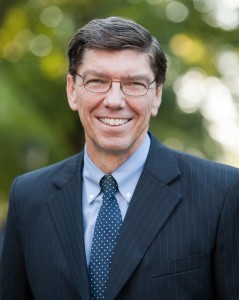Jill Disrupts Clayton (Sort Of)

I’ve been disrupted!
My career has been a steady diet of disruption.
Three times, disruptive innovations rocked the companies I worked for. First, the PC destroyed the word processing industry (which had destroyed the typewriter industry). Second, client/server applications disrupted host-centric applications. Third, cloud-based applications disrupted client/server applications.
Twice, my companies disrupted other companies. First, RISC processors disrupted CISC processors. Second, voice applications disrupted traditional call centers.
In 1997, a Harvard professor named Clayton Christensen (pictured) took examples like these and fashioned a theory of disruptive innovation. In The Innovator’s Dilemma, he explained how it works: Your company is doing just fine and understands exactly what customers need. You focus on offering customers more of what they want. Then an alternative comes along that offers less of what customers want but is easier to use, more convenient, and less costly, etc. You dismiss it as a toy. It eats your lunch.
The disruptive innovation typically offers less functionality than the product it disrupts. Early mobile phones offered worse voice quality than landlines. Early digital cameras produced worse pictures than film. But, they all offered something else that appealed to consumers: mobility, simplicity, immediate gratification, multi-functionality, lower cost, and so on. They were good enough on the traditional metrics and offered something new and appealing that tipped the balance.
My early experiences with disruption – before Christensen wrote his book — were especially painful. We didn’t understand what was happening to us. Why would customers choose an inferior product? We read books like Extraordinary Popular Delusions and The Madness of Crowds to try to understand. Was modern technology really nothing more than an updated version of tulip mania?
After Christensen’s book came out, we wised up a bit and learned how to defend against disruptions. It’s not easy but, at the very least, we have a theory. Still, disruptions show no sign of abating. Lyft and Uber are disrupting traditional taxi services. AirBnB is disrupting hotels. And MOOCs may be disrupting higher education (or maybe not).
Such disruption happens often enough that it seems almost intuitive to me. So, I was surprised when another Harvard professor, Jill Lepore, published a “take-down” article on disruptive innovation in a recent edition of The New Yorker.
Lepore’s article, “The Disruption Machine: What The Gospel of Innovation Gets Wrong”, appears to pick apart the foundation of Christensen’s work. Some of the examples from 1997 seem less prescient now. Some companies that were disrupted in the 90s have recovered since. (Perhaps we did get smarter). Disruptive companies, on the other hand, have not necessarily thrived. (Perhaps they, too, were disrupted).
Lepore points out that Christensen started a stock fund based on his theories in March 2000. Less than a year later, it was “quietly liquidated.” Unfortunately, she doesn’t mention that March 2000 was the very moment that the Internet bubble burst. Christensen may have had a good theory but he had terrible timing.
But what really irks Lepore is given away in her subtitle. It’s the idea that Christensen’s work has become “gospel”. People accept it on faith and try to explain everything with it. Consultants have take Christensen’s ideas to the far corners of the world. (Full disclosure: I do a bit of this myself). In all the fuss, Lepore worries that disruptive innovation has not been properly criticized. It hasn’t been picked at in the same way as, say, Darwinism.
Lepore may be right but it doesn’t mean that Christensen is wrong. In the business world, we sometimes take ideas too literally and extend them too far. As I began my career, Peters and Waterman’s In Search of Excellence was almost gospel. We readers probably fell in love a little too fast. Yet Peters and Waterman had – and still have — some real wisdom to offer. (See The Hype Cycle for how this works).
I’ve read all but one of Christensens’s books and I don’t see any evidence that he promotes his work as a be-all, end-all grand Theory of Everything. He’s made careful observations and identified patterns that occur regularly. Is it a religion? No. But Christensen offers a good explanation of how an important part of the world works. I know. I’ve been there.